Disclosure: We may earn commissions if you purchase products after clicking on a link from our site.
Would you like to learn how to catch cod? Cod is a highly sought-after fish as it is very nutritional. It is a bottom feeder and can be challenging to catch because it can be hard to find. However, with the right fishing method, bait, and equipment, you can catch this popular and heart-healthy fish. In this article, we share information, techniques, and tips to improve your chances of catching more cod.
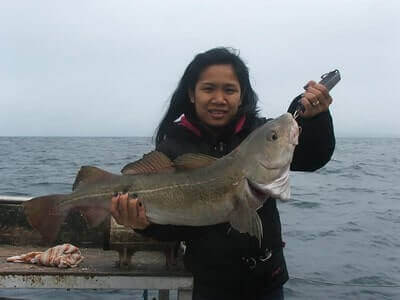
Table of Contents
How To Catch Cod
1. Drifting
Drifting is a popular fishing method used to catch cod, particularly in offshore waters where cod are abundant. This technique involves allowing the boat to drift naturally with the current while anglers deploy bait or lures at varying depths to entice cod bites.
As the boat drifts, anglers continuously adjust their bait presentation to cover different depths and areas of the water column where cod may be feeding. This method is effective for covering large areas of water and locating active fish.
Anglers often use a variety of bait, such as squid, mackerel, or herring, rigged on multi-hook setups or weighted rigs to target cod effectively during the drift. Additionally, artificial lures like jigs or soft plastics can also be employed to mimic the movement of prey and attract strikes from cod.
Drifting allows anglers to explore different depths and structures where cod are likely to congregate, increasing the chances of a successful catch. For more information on fishing regulations and techniques for cod, anglers can refer to resources provided by the National Oceanic and Atmospheric Administration (NOAA) Fisheries at this link.
2. Trolling
Trolling is a widely used fishing method for catching cod, especially in deeper waters where these fish are often found. Anglers employ this technique by trailing baited lines or lures behind a moving boat, covering a wide area as they search for active fish.
The trolling speed can vary depending on the preference of the angler and the conditions of the water. Common baits used for trolling include squid, herring, mackerel, and artificial lures designed to mimic the movement of prey. Trolling allows anglers to cover large expanses of water, exploring different depths and structures where cod may be feeding or schooling.
This method is particularly effective for targeting cod in offshore environments or along underwater structures such as reefs, drop-offs, or underwater pinnacles. Anglers often use downriggers or planer boards to control the depth at which their baits or lures are presented, maximizing their chances of enticing strikes from cod at various depths. Trolling for cod can be a productive and exciting fishing method, offering anglers the opportunity to catch these prized fish while enjoying the thrill of being out on the water.
3. Jigging
Jigging is a popular and effective fishing method for targeting cod, particularly in deeper waters or areas with rocky bottoms where these fish often congregate. Anglers use specialized jigs, which are weighted hooks adorned with feathers, rubber skirts, or other enticing materials, to mimic the movement of prey.
By dropping the jig to the desired depth and then jerking it upwards in a rhythmic motion, anglers create an enticing action that can trigger strikes from cod lurking below. Jigging allows anglers to cover different depths and structures, from the seabed to midwater and beyond, making it versatile for various fishing conditions.
Additionally, anglers can adjust the weight of the jig and the speed of their retrieves to match the preferences of the cod and the conditions of the water. This method requires some skill and finesse to master but can yield rewarding results, with cod often taking jigs aggressively when they are feeding actively.
Whether fishing from a boat or shore, jigging for cod can provide anglers with an exciting and productive fishing experience, offering the chance to hook into these prized fish while enjoying the thrill of the chase.
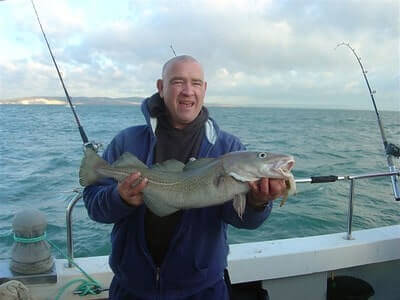
4. Still Fishing
Still fishing, also known as bait fishing or bottom fishing, is a traditional and straightforward method for targeting cod. Anglers using this method typically anchor their boat in an area known to hold cod or fish from shore along rocky outcrops or jetties where cod are likely to feed.
The technique involves presenting bait on or near the bottom using rigs such as a fishfinder rig or a simple dropper rig with a sinker to keep the bait stationary. Popular baits for still fishing include cut fish, squid, clams, and shrimp, which are often impaled on hooks and dropped to the seabed.
Once the bait is set, anglers wait patiently for cod to find and take the bait. Still fishing allows anglers to cover a specific area thoroughly and can be effective in areas with strong currents or where jigging and trolling may be less practical.
While it may lack the active engagement of other methods, still fishing for cod can be relaxing and rewarding, offering anglers the opportunity to connect with nature while waiting for a bite from these prized fish.
5. Bottom Bouncing
Bottom bouncing is a dynamic fishing technique often employed by anglers targeting cod in deeper waters. This method involves the use of specialized rigs equipped with heavy sinkers designed to drag along the seabed while the boat is in motion.
Anglers typically drift or slowly motor over productive areas, allowing the weighted rig to make contact with the bottom intermittently as it moves. This bouncing action stirs up sediment and creates a disturbance, attracting the attention of cod lurking near the ocean floor.
Common setups for bottom bouncing include rigs like the three-way swivel rig or the drop-shot rig, which suspend bait slightly above the bouncing sinker to prevent snagging. Baits used for bottom bouncing can vary but often include cut bait, squid strips, or artificial lures designed to mimic the movements of prey fish.
Bottom bouncing requires precise boat control to maintain the desired depth and speed, making it a challenging yet effective method for enticing cod to strike. Anglers must remain attentive to changes in water depth and structure to maximize their chances of success when employing this technique to catch cod.
Cod Tackle Setup
A heavy-duty, fast-action fishing rod rated for 50 pounds with a length of 6 to 8 feet will work for catching cod. Use a 30 to 50-lb braided line. Use hooks from 1 and 6/0 although it depends on the bait and whether you are fishing inshore or offshore.
Use a hook from 3/0 to 5/0 hook when fishing in deep waters and use a smaller hook from 2/0 to 3/0 hook when fishing close to the shore.
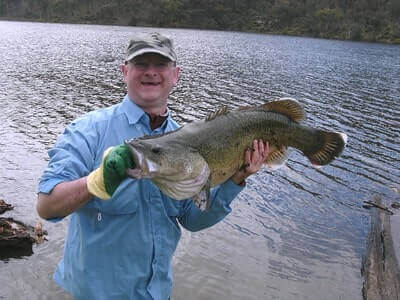
How To Catch Cod From A Boat
1. Still Fishing
When fishing for cod from a boat, you can implement still fishing. With this method, you drop your bait into the water and wait for a strike. Still fishing is simple but effective in catching fish.
It can be implemented not only from a boat, but also from the shore, a pier, a dock, or a bridge. it is an excellent way for beginners to start their fishing careers.
2. Trolling
Trolling is a fishing method that is widely used when fishing from a boat. You attach the bait or lure to the line and slowly move the boat about 3 to 7 knots.
3. Jigging
Jigging can be used to catch cod when you fish from a boat. When jigging, you drop your line in the water and let it sink to the bottom. When you feel it touch the bottom, quickly pop the fishing rod, and then it drops back down to the bottom.
You can do vertical jigging which is up-and-down jigging or you can implement side-to-side jigging. Either way, the movement will attract the attention of the cod and it might bite at the bait taking it to be live prey.
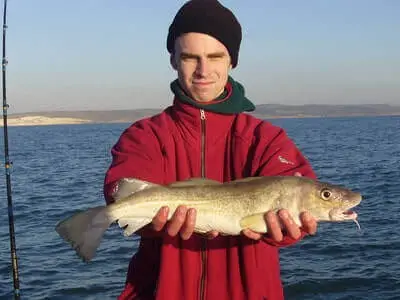
4. Bottom Bouncing
Bottom bouncing allows you to locate and attract fish. When implementing bottom bouncing technique, use a natural bait or bucktail jig and drag it on the bottom of the seafloor. Drag it so that it stirs up mud or sand to get the attention of fish for them to strike. When you get bites, then anchor the boat and implement other fishing methods like drifting, still fishing, or jigging to catch fish.
5. Drifting
Drifting can be done on a boat by casting your line upstream and letting it be carried with the current. Then slowly reel it in as the line drifts downward. if you don’t get a bite, you repeat the process until you are successful.
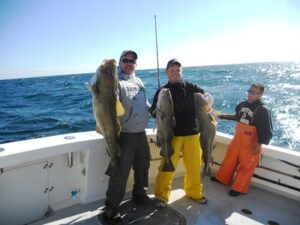
How To Catch Cod From The Shore
When fishing for cod from the shore look for areas with structures like wrecks, drops, points, cut-offs, rocky areas, jetties, deep holes, pockets, and troughs where cods may be hiding to ambush baitfish. Additionally, look for rip currents that separate the sandbars. The rip currents take along food for cod from the surf zone into the open sea.
You will often find cod coming closer to the shoreline at night as they feel more secure during the night. Hence, fishing for cod during the night can yield better results. Additionally, when fishing for cod from the shore, always make fast and regular line retrievals to keep the bait fresh and smelly.
1. Drifting
Drifting can be used to fish for cod. It allows you to search a variety of habitats for cod. When drift fishing, you cast your line upstream and let it drift downward with the current. Then slowly reel in the line as it moves downward. If you don’t get a strike, repeat the process until you get strikes.
2. Still Fishing
You can fish for cod from the shore using still fishing. Find a pier, dock, wreck, or other structure that cod like to hide in and drop your bait into the water, and wait for a bite. When you get a bite, try to hook it and reel in the line. Still fishing is a simple and effective way of fish that is ideal for beginners.
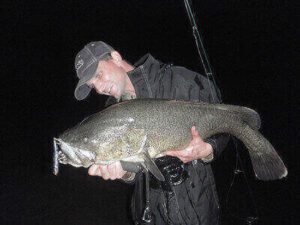
3. Casting
You can fish for cod from the shore by casting. Hook the bait or lure on and cast it into the waters near the shore. When you feel a bite on your line, quickly reel in the line. Casting is one of the popular methods of catching fish.
When fishing from the shore, study the water to observe the current, and identify structures that fish may be hiding in to ambush their prey like troughs, wrecks, deep holes, jetties, and pockets. Catching cod from the shore requires good casting skills and you will have to continuously work on improving your casting skills.
Best Bait For Cod
1. Herring
Herring is a popular and effective bait choice for anglers targeting cod. Its natural oils and strong scent make it highly attractive to cod, enticing them to strike. Anglers often use fresh or frozen herring, either whole or in chunks, depending on the size of the fish they’re targeting and the fishing conditions.
Whole herring can be rigged on a hook to mimic live baitfish, while chunks can be threaded onto a fishing rig or jighead. Some anglers also use brined or cured herring, which can enhance its durability and scent trail in the water. Herring is particularly effective when fishing in areas where cod are known to feed on smaller baitfish, such as rocky reefs, offshore structures, or deep channels.
When using herring as bait for cod fishing, it’s essential to match the size of the bait to the size of the fish and adjust the rigging technique accordingly. Additionally, anglers should consider the presentation and depth at which the bait is presented to maximize its effectiveness in enticing cod to bite.
2. Sprat
Sprat, a small baitfish belonging to the herring family, is a valuable bait option for cod fishing. Its silvery scales and oily flesh make it an enticing meal for cod, attracting them with its natural scent and appearance.
Anglers often use fresh or frozen sprat, either whole or in chunks, depending on the size of the fish they’re targeting and the fishing conditions. Whole sprat can be rigged on a hook to mimic live baitfish, while chunks can be threaded onto a fishing rig or jighead.
Some anglers also prefer to brine or cure sprat, enhancing its durability and scent trail in the water. Sprat is particularly effective when fishing in areas where cod are known to feed on smaller baitfish, such as rocky reefs, offshore structures, or deep channels.
When using sprat as bait for cod fishing, it’s essential to match the size of the bait to the size of the fish and adjust the rigging technique accordingly. Additionally, anglers should consider the presentation and depth at which the bait is presented to maximize its effectiveness in enticing cod to bite.
3. Capelin
Capelin, a small and silver-colored fish found in the North Atlantic, is a popular bait choice for cod fishing. These baitfish are known for their oily flesh and strong scent, making them highly attractive to cod.
Anglers often use fresh or frozen capelin as bait, either whole or in chunks, depending on the fishing conditions and the size of the targeted cod. Whole capelin can be rigged on a hook to mimic live baitfish swimming in the water, while chunks can be threaded onto a fishing rig or jighead.
Some anglers also prefer to brine or cure capelin, enhancing its durability and scent trail to attract cod over a longer period. Capelin is particularly effective when fishing in areas where cod are known to gather, such as rocky reefs, offshore structures, or deep channels.
When using capelin as bait for cod fishing, it’s essential to consider the size of the bait relative to the size of the targeted fish and adjust the rigging technique accordingly for optimal presentation and effectiveness.
4. Sand eels
Sand eels are slender, elongated fish commonly used as bait for cod fishing in coastal waters. Their resemblance to small eels and their availability in various sizes make them an attractive choice for anglers targeting cod.
Sand eels are known for their natural swimming action, which can entice cod to strike. Anglers often rig sand eels on hooks or jigheads, either whole or in sections, depending on the size of the baitfish and the preferences of the fisherman. They can be fished near the bottom or at mid-water depths, where cod are known to feed.
Sand eels are particularly effective in areas where cod gather to feed, such as sandy bottoms, rocky outcrops, or underwater structures. Their oily flesh and strong scent make them highly appealing to cod, enticing bites even in challenging fishing conditions.
When using sand eels as bait for cod fishing, anglers should ensure the bait is rigged securely to prevent it from slipping off during casting or retrieving, maximizing its effectiveness in attracting and hooking cod.
5. Irish Moss
Irish moss, also known as carrageen moss, is a type of seaweed commonly found along rocky coastlines, particularly in colder waters like those surrounding Ireland and parts of the North Atlantic. While Irish moss itself is not typically used as bait for cod fishing, it can indirectly attract cod by providing habitat for smaller baitfish and invertebrates that cod feed on.
In areas where Irish moss is abundant, it can serve as a natural nursery for various marine organisms that form the prey base for cod. Anglers targeting cod may find success fishing near patches of Irish moss, as these areas often harbor an abundance of small fish and crustaceans, which, in turn, attract hungry cod.
Additionally, Irish moss can sometimes become entangled in fishing lines or hooks, inadvertently serving as extra cover for bait or lures. While not a direct bait option, Irish moss plays a role in cod fishing by supporting the ecosystem that sustains the species anglers seek to catch.
6. Squid
Squid is a popular and effective bait for cod fishing due to its strong scent, durability, and resemblance to natural prey. Cod are known to be voracious feeders and are attracted to the scent and movement of squid. Anglers often use whole squid or squid strips as bait, either fresh or frozen.
Whole squid can be rigged onto a fishing hook to mimic swimming prey, while squid strips are often cut into smaller pieces to make them more manageable and to expose more scent to the water. Squid bait is versatile and can be used in various fishing techniques such as bottom fishing, jigging, or trolling.
When fishing for cod with squid, it’s essential to keep the bait moving slightly to simulate live prey, as this can increase the chances of attracting bites. Additionally, squid is readily available in many bait shops and can be stored easily, making it a convenient and reliable option for anglers targeting cod in both saltwater and freshwater environments.
7. Crabs
Crabs are a natural and enticing bait for cod fishing, particularly in areas where crabs are abundant and cod are prevalent. The strong scent and taste of crab meat can attract cod from a distance, making it a popular choice among anglers.
Crabs can be used whole or as pieces, depending on the size of the cod being targeted and the fishing method employed. Whole crabs can be rigged onto fishing hooks to mimic live prey, while crab pieces can be used as bait for bottom fishing rigs or jigging setups. In regions where crabs are a common food source for cod, using crab bait can be highly effective in enticing bites.
However, anglers should consider the availability of crabs in their fishing area and the preferences of the local cod population when selecting bait. Additionally, using fresh or live crabs can yield better results compared to frozen or processed bait, as they release more scent into the water, attracting cod more effectively.
8. Mussels
Mussels can be an effective bait for cod fishing in certain situations. These shellfish are naturally abundant in many coastal areas and can be readily available for anglers to use as bait. Cod are known to feed on mussels, attracted by both their scent and taste.
Anglers can rig mussels onto fishing hooks either whole or in pieces, depending on the size of the cod being targeted and the fishing method being employed. When fishing with mussels, it’s often best to use them fresh or alive whenever possible, as they release more scent into the water, making them more attractive to cod.
Mussels can be particularly effective when fishing in rocky areas or near mussel beds where cod are known to congregate. However, it’s essential to consider local regulations and restrictions regarding the harvesting and use of mussels for bait, as well as the preferences of the cod population in the area. Overall, mussels can be a valuable bait option for anglers targeting cod in coastal waters.
9. Clams
Clams, like mussels, are also used as bait for cod and other fish. They can be found on the beach in the sand or under rocks and other structures. It may be an issue of your time searching for them rather than spending money to buy bait.
10. Octopus
Octopus can be an effective and versatile bait for cod fishing in various locations. Its tough texture and strong scent make it appealing to cod, enticing them to bite. Anglers often use octopus as bait by cutting it into strips or chunks, allowing the juices and scent to disperse in the water, attracting cod to the baited area.
Octopus is especially useful in areas where cod are prevalent and actively feeding on cephalopods and other marine creatures. Additionally, octopus can withstand the attention of smaller fish and scavengers, allowing it to remain on the hook longer, increasing the chances of attracting larger cod.
When using octopus as bait, anglers should ensure that it is fresh or properly preserved to maintain its effectiveness. Overall, octopus can be a highly productive bait option for anglers targeting cod in both saltwater and freshwater environments.
11. Nightcrawlers
Nightcrawlers, also known as earthworms, are a popular and effective bait for cod fishing, especially in freshwater environments where cod are present. These large, wriggling worms emit a strong scent and natural movement that attracts cod, enticing them to strike.
Anglers typically rig nightcrawlers on hooks using a variety of techniques, such as threading them onto the hook or presenting them whole, depending on the fishing conditions and preferences. When fishing for cod with nightcrawlers, anglers often target areas with rocky bottoms, submerged structures, or areas with vegetation where cod tend to congregate in search of food.
Nightcrawlers can be particularly effective during low-light conditions or at night when cod are more active and feeding near the bottom. Overall, nightcrawlers are a versatile and reliable bait option for anglers targeting cod in freshwater lakes, rivers, and reservoirs.
12. White Ragworms
White ragworms, also known as harbor ragworms or sandworms, are a favored bait for cod fishing in coastal waters. These segmented marine worms possess a strong scent and lively movement that appeals to cod, making them highly effective bait options.
Anglers often rig white ragworms on hooks using various methods, such as threading them onto the hook or presenting them whole, depending on the fishing conditions and the size of the worms. When fishing for cod with white ragworms, anglers target areas with rocky bottoms, submerged structures, or underwater channels where cod are known to inhabit and feed.
White ragworms can be particularly productive when used in conjunction with natural drift rigs or bottom fishing rigs, allowing them to drift naturally in the water column or rest on the seabed to entice cod strikes. Overall, white ragworms are prized by anglers for their effectiveness in enticing cod bites, making them a valuable bait choice for cod fishing expeditions along coastal regions.
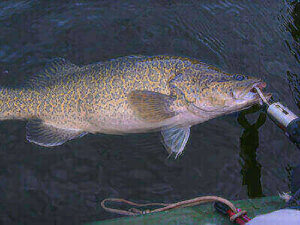
Best Lures For Cod
1. Spinners
Spinners are versatile and effective lures for cod fishing in both freshwater and saltwater environments. Typically consisting of a metal blade that spins around a central wire shaft, spinners mimic the movement of small fish or other prey items, attracting the attention of hungry cod.
Anglers can choose from a variety of spinner designs, including inline spinners and spinnerbaits, each offering unique characteristics and presentations. Inline spinners are particularly popular for cod fishing, featuring a spinning blade that creates flash and vibration as it moves through the water, mimicking the erratic movement of injured baitfish.
Spinnerbaits, on the other hand, often incorporate a skirt or trailer along with the spinning blade, providing additional visual appeal and bulk to attract cod. Anglers can vary the retrieve speed and depth to effectively target cod holding at different water depths and locations.
Additionally, spinners are known for their durability and ease of use, making them suitable for anglers of all skill levels. Overall, spinners are reliable lures that can entice aggressive strikes from cod in a variety of fishing situations, making them valuable additions to any angler’s tackle box.
2. Bucktails
Bucktails are highly effective lures for cod fishing, particularly in saltwater environments where these predatory fish are abundant. These lures consist of a lead jig head adorned with a skirt made of hair or synthetic material, resembling the tail of a small baitfish.
Anglers often use bucktails with a strip of bait or a soft plastic trailer to enhance their effectiveness further. Whether cast and retrieved or jigged vertically, bucktails excel at enticing strikes from cod, making them a staple in many anglers’ tackle boxes when targeting these prized fish. Their durability and simplicity make them suitable for anglers of all skill levels, from novices to seasoned veterans, looking to hook into a hard-fighting cod.
3. Spoons
Spoons are popular lures among anglers targeting cod due to their versatility and effectiveness in imitating baitfish. These lures typically feature a curved, concave metal body with a reflective finish that mimics the flash and movement of injured baitfish.
When retrieved through the water, spoons produce a distinctive wobbling action that attracts the attention of predatory cod. They can be cast and retrieved, trolled behind a boat, or jigged vertically, making them suitable for various fishing scenarios and depths.
Anglers can customize their presentation by adjusting the speed of retrieve or adding bait to the treble hook for added scent and attraction. Spoons come in a range of sizes, colors, and finishes to match the local forage and water conditions.
They are especially effective in clear water where the flash and vibration produced by the spoon can grab the attention of cod from a distance. Whether fishing inshore or offshore, spoons are a reliable option for anglers targeting cod and are a staple in many tackle boxes for their proven ability to produce strikes consistently.
4. Chrome Diamond Jigs
Chrome diamond jigs are highly effective lures for cod fishing, particularly in deep water or when targeting larger specimens. These jigs are characterized by their diamond-shaped body made of chrome-plated metal, which reflects light and produces a flashy appearance underwater.
The streamlined design allows them to sink quickly to the desired depth, making them ideal for vertical jigging or bottom bouncing techniques. When jigged off the bottom, chrome diamond jigs create an enticing fluttering motion that mimics injured or fleeing baitfish, attracting the attention of hungry cod.
They are versatile lures that can be used in various fishing environments, including rocky bottoms, wrecks, and offshore reefs. Anglers often tip the hook with bait such as squid or strip bait to increase their appeal.
The weight of chrome diamond jigs enables anglers to fish at different depths and currents, making them suitable for both novice and experienced fishermen. Their durability and effectiveness make them a staple in the tackle box of many cod anglers, especially when targeting larger fish in deeper waters.
5. Tube Jigs
Tube jigs are a popular and effective lure choice for cod fishing, particularly in areas with rocky bottoms or strong currents. These lures consist of a hollow, cylindrical plastic body with a soft, tentacle-like skirt that mimics the movement of baitfish or squid underwater.
The hollow body allows anglers to insert a weighted jig head, which provides the necessary weight for casting or jigging. Tube jigs are versatile and can be rigged with single or treble hooks depending on angler preference and fishing conditions. When jigged off the bottom, the soft skirt undulates enticingly, attracting the attention of cod lurking in the vicinity.
Anglers often tip the hook with bait such as squid or strip bait to add scent and increase the lure’s appeal. Tube jigs come in various sizes and colors to match the local baitfish and water conditions. They are particularly effective when fished near underwater structures such as wrecks, reefs, or ledges, where cod tend to congregate. Overall, tube jigs are a reliable and productive option for targeting cod in a wide range of fishing environments.
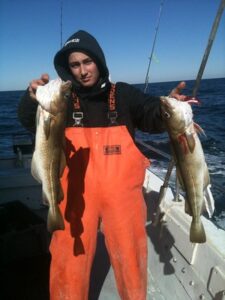
Boat Fishing Rigs For Cod
1. Diamond Jig Rig
The diamond jig rig is a popular choice among anglers targeting cod, known for its simplicity and effectiveness. This rig typically consists of a diamond-shaped metal jig with a single or treble hook attached at the bottom.
The jig is often adorned with reflective tape or paint to mimic the appearance of baitfish, making it highly attractive to cod. Anglers can vary the weight of the jig depending on the depth and current conditions of the fishing area. The diamond jig rig is versatile and can be used for both casting and jigging techniques.
When casting, anglers retrieve the jig with a steady, rhythmic motion to imitate the swimming action of a wounded baitfish. Alternatively, when jigging, anglers drop the jig to the bottom and then lift and lower the rod tip in a jerking motion to mimic the movement of prey. This rig is effective when fishing over rocky bottoms, wrecks, or reefs where cod are known to inhabit. The diamond jig rig’s simplicity, durability, and ability to attract fish in a variety of conditions make it a go-to option for many cod anglers.
2. Pennell Pulley Rig
The Pennell pulley rig is a specialized setup used by anglers targeting cod, particularly in areas with strong currents or rough seabeds. This rig consists of two hooks positioned in tandem, with the top hook set slightly behind and above the bottom hook.
The top hook is typically larger than the bottom hook to accommodate larger baits such as whole squid, mackerel, or fish fillets. Both hooks are rigged on separate snoods, allowing them to move independently. The unique feature of the Pennell pulley rig is the use of a sliding swivel or pulley bead positioned above the hooks. This allows the weight to slide up the mainline when a fish is hooked, minimizing the risk of the weight becoming snagged on the seabed or structure.
Additionally, the sliding swivel helps to keep the fish away from the mainline, reducing the chances of the fish using its weight to leverage against the angler’s efforts. The Pennell pulley rig is particularly effective when fishing in deep waters or areas with strong currents where traditional rigs may struggle to maintain bottom contact. Its design minimizes tangles and snags, making it a popular choice among anglers targeting cod in challenging fishing conditions.
3. Two-Hook Loop Rig
The two-hook loop rig is a versatile and effective setup commonly used by anglers targeting cod in various fishing environments. This rig consists of a mainline with two dropper loops positioned along its length, each holding a hook. The dropper loops are typically spaced several feet apart to present multiple baits at different depths, increasing the chances of enticing cod to strike.
Anglers often use circle hooks or Aberdeen hooks with this rig to securely hook the fish while minimizing damage to the catch. The two-hook loop rig allows anglers to present a variety of baits simultaneously, such as squid, mackerel strips, or sand eels, to cater to the preferences of cod in different conditions.
Additionally, the rig’s simplicity and ease of setup make it a popular choice among beginners and experienced anglers alike. Whether fishing from a boat, pier, or shore, the two-hook loop rig offers versatility and effectiveness for targeting cod in diverse fishing environments.
4. One-Hook Clipped Paternoster Rig
The One-Hook Clipped Paternoster Rig is a popular and effective setup for targeting cod in both offshore and inshore environments. This rig features a mainline with a single dropper loop positioned near the bottom, holding a single hook. A clip or swivel is attached to the end of the mainline for securing weight or a sinker.
The simplicity of this rig allows for quick and easy bait changes while providing a streamlined presentation to attract cod. Anglers often use bait such as squid, mackerel strips, or sand eels on the hook to entice cod to strike. The position of the hook near the bottom ensures that it remains in the strike zone where cod are typically found, making it an effective rig for targeting these bottom-dwelling fish.
Additionally, the clipped design of the rig minimizes tangles and ensures that the bait remains in optimal position throughout the fishing session. Whether fishing from a boat, pier, or shoreline, the One-Hook Clipped Paternoster Rig is a versatile and reliable choice for anglers targeting cod.
5. Rotten Bottom Rig
The rotten bottom rig is a specialized setup designed to minimize the risk of losing tackle when targeting cod in rocky or snaggy environments. This rig consists of a mainline attached to a swivel, which in turn is connected to a short length of lighter line known as the weak link or rotten bottom.
The weak link is intentionally weaker than the mainline and is designed to break under pressure, allowing anglers to retrieve their rig without losing the entire setup if it becomes snagged. Above the swivel, anglers can attach a leader line with a baited hook or lure.
When a fish takes the bait and is hooked, the weak link breaks, allowing the angler to fight and land the fish while leaving the snagged tackle behind. This rig is particularly useful when fishing in areas with rocky seabeds or wrecks where the risk of getting snagged is high. By sacrificing only the weaker section of line, anglers can maximize their chances of landing cod while minimizing the frustration and expense of losing tackle to underwater obstacles.
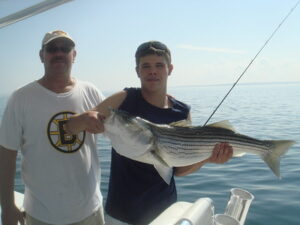
Cod Fishing Tips
1. The cod can be found in depths of 200 to 1300 feet.
2. Live bait is the best bait to catch cod.
3. Cod is also caught using deep trolling, jigging, still fishing, drifting, and bottom bouncing.
4. Fish for cod in cooler waters.
5. Cod is a bottom-dwelling fish. You will have to fish for them in deep waters.
6. Cod mostly feeds on prey that lives on the ocean floor.
7. Increase your chances of attracting cod by adding brightly-colored grubs to your hook.
8. When the bait or jig hits the sea floor, jerk it slightly up and down to create movement. The movement will make the bait or jig appear like a living animal which will attract cod.
9. Once there is a tug on the line, pull up your rod to keep the line tight. Reel in the line if the cod seems to be swimming toward you and stop reeling if it swims away from you.
10. Don’t overload the hook with bait.
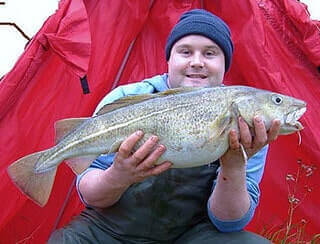
11. Use a red line as the red color disappears in the water and improves your catch rate.
12. Cod comes closer to the shore at night as it feels more secure and that can increase your chances of catching cod.
13. You can catch more cod when there are spring tides as they use the tides to find prey.
14. Cod is a fish of habit. If you find a good spot where you catch them, it is most likely their feeding spot and they will often return there to feed.
15. Don’t cover the barb of the hook when you are putting bait on your hook.
16. When the sea is calm, look for cod in white water near gullies or rocks.
17. Use two different rods. One short-range and one long-range rod. This allows you to fish two different ways and has chances to catch cod because cod may come close to shore.
18. Make sure your fishing location has muddy or dirty areas of water as cod does not like clear water.
19. If you are doing inshore fishing, the best time to catch cod is in the evening as they are closer to the shore.
20. Your chances of catching cod increase right after a storm because the storm churns up the water and the cod food settles on the seabed.
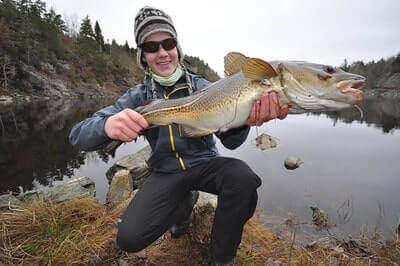
21. Use a rattle or jingle on a jig as cods are attracted to noise.
22. Fishing for cod at night can be more productive as they feel more secure at night from predators.
23. Trolling, still fishing, drifting, jigging, casting, and bottom bouncing are some of the methods used to fish for cod.
24. When fishing for cod close to the shore, look for rip currents that separate the sandbars.
25. Look for drops, points, and cut-off areas within your casting range and try to target those areas for cod.
26. When fishing for cod from the shore, you will need to cast your line at a distance that exceeds the first breakers of the surf zone.
27. Cod prefers mixed seabeds where there is a mixture of kelp, rock piles, and weeds.
28. Visit the shoreline at low tide to identify structures that could be hiding areas for cod and target those areas at high tide.
29. Cod will come into the surf zone when the surf conditions are choppy with a light swell and murky waters.
30. High tide is the best time to catch cod from the shore.
31. Offshore winds will not only result in more bites and catches, but they will also improve your casting distance when you fish from the shoreline.

The Bottom Line
Cod is one of the nutritional fishes that is highly sought after by anglers. They are often found deep inshore but can be found closer to the shore sometimes and mostly at night. To catch cod, you must find the area where they are located, have the right baits and lures, and use the right equipment.
In this article, we share information, knowledge, tips, and fishing methods to help you catch more cod. If you are interested in fishing for other fishes like pollock, kingfish, and red snapper, then read how to catch pollock, how to catch kingfish, and how to catch red snapper.